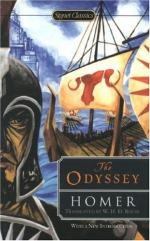{84} Literally “for the ways of the night and of the day are near.” I have seen what Mr. Andrew Lang says ("Homer and the Epic,” p.236, and “Longman’s Magazine” for January, 1898, p.277) about the “amber route” and the “Sacred Way” in this connection; but until he gives his grounds for holding that the Mediterranean peoples in the Odyssean age used to go far North for their amber instead of getting it in Sicily, where it is still found in considerable quantities, I do not know what weight I ought to attach to his opinion. I have been unable to find grounds for asserting that B.C. 1000 there was any commerce between the Mediterranean and the “Far North,” but I shall be very ready to learn if Mr. Lang will enlighten me. See “The Authoress of the Odyssey” pp. 185-186.
{85} One would have thought that when the sun was driving the stag down to the water, Ulysses might have observed its whereabouts.
{86} See Hobbes of Malmesbury’s translation.
{87} “Il.” vxiii. 349. Again the writer draws from the washing the body of Patroclus—which offends.
{88} This visit is wholly without topographical significance.
{89} Brides presented themselves instinctively to the imagination of the writer, as the phase of humanity which she found most interesting.
{90} Ulysses was, in fact, to become a missionary and preach Neptune to people who knew not his name. I was fortunate enough to meet in Sicily a woman carrying one of these winnowing shovels; it was not much shorter than an oar, and I was able at once to see what the writer of the “Odyssey” intended.
{91} I suppose the lines I have enclosed in brackets to have been added by the author when she enlarged her original scheme by the addition of books i.-iv. and xiii. (from line 187)-xxiv. The reader will observe that in the corresponding passage (xii. 137-141) the prophecy ends with “after losing all your comrades,” and that there is no allusion to the suitors. For fuller explanation see “The Authoress of the Odyssey” pp. 254-255.
{92} The reader will remember that we are in the first year of Ulysses’ wanderings, Telemachus therefore was only eleven years old. The same anachronism is made later on in this book. See “The Authoress of the Odyssey” pp. 132-133.
{93} Tradition says that she had hanged herself. Cf. “Odyssey” xv. 355, etc.
{94} Not to be confounded with Aeolus king of the winds.
{95} Melampus, vide book xv. 223, etc.
{96} I have already said in a note on bk. xi. 186 that at this point of Ulysses’ voyage Telemachus could only be between eleven and twelve years old.
{97} Is the writer a man or a woman?
{98} Cf. “Il.” iv. 521, [Greek]. The Odyssean line reads, [Greek]. The famous dactylism, therefore, of the Odyssean line was probably suggested by that of the Ileadic rather than by a desire to accommodate sound to sense. At any rate the double coincidence of a dactylic line, and an ending [Greek], seems conclusive as to the familiarity of the writer of the “Odyssey” with the Iliadic line.




